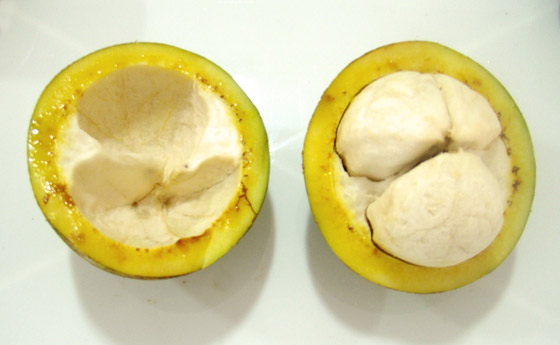Have you ever wondered how many delicious fruits start with the letter B? You might be surprised to discover just how many tasty options are out there! Many people stick to the usual fruits, but there’s a whole world of variety waiting to be explored. In this blog post, we’ll take you on a journey through 40+ incredible fruits that start with the letter B. From the familiar to the exotic, you’ll learn about their unique flavors, benefits, and how to enjoy them. Ready to expand your fruit knowledge? Let’s dive in!
- Babaco
Babaco is a unique tropical fruit that originates from the Andes Mountains in Ecuador. It has a pale yellow skin and a soft, juicy interior that is similar to papaya but with a more tangy flavor. The fruit is typically oblong and can be eaten raw or used in smoothies, salads, and desserts.
Babaco is known for being high in vitamin C and digestive enzymes, making it good for the immune system and digestion. People enjoy its refreshing, mildly sweet flavor and use it to add a tropical touch to dishes. Babaco is related to other tropical fruits like papaya and pineapple and is often found in South American markets.
- Bacuri

Bacuri is a tropical fruit native to the Amazon rainforest, primarily found in Brazil. The fruit has a thick, green rind and soft, creamy white pulp inside, which is sweet, tangy, and aromatic. Bacuri is often used to make juices, ice creams, and desserts due to its rich flavor.
People appreciate bacuri for its distinct taste and high nutritional value, as it contains vitamins and antioxidants that are good for the skin and immune system. It’s a popular ingredient in traditional Brazilian cuisine and is associated with the rich biodiversity of the Amazon. Bacuri is related to other Amazonian fruits like cupuaçu and maracuja (passion fruit).
- Bael
Bael is a fruit that grows on the Aegle marmelos tree, which is native to India and Southeast Asia. The fruit is round with a hard, woody shell, and when cut open, it reveals a sweet, aromatic pulp with seeds. Bael has a unique flavor that is both sweet and slightly tangy, and it’s often used in traditional Indian sweets, juices, and herbal medicines.Bael is highly valued for its health benefits, including aiding digestion and boosting the immune system. It is commonly consumed during the summer months to cool the body and improve gut health. The fruit is linked to Ayurvedic medicine and is often found in tropical regions of Asia, where it’s also associated with cultural and religious practices.
- Balsam Apple
- Banana
- Baobab
Baobab is a large, nutrient-packed fruit that grows on the baobab tree, native to Africa, Australia, and Madagascar. The fruit has a hard, dry outer shell, and inside, it contains a powdery, tangy pulp filled with seeds. The pulp is naturally rich in vitamin C, fiber, and antioxidants, which is why it’s often used in smoothies, juices, or as a supplement.
People enjoy baobab for its health benefits, particularly for boosting the immune system and supporting digestion. It has a tart, citrus-like flavor, and is considered a superfood due to its high nutritional value. Baobab is commonly found in African cuisine and wellness products, often linked to traditional medicine and tropical superfoods.
- Barbadine
Barbadine is a large, tropical fruit native to the Caribbean, South America, and parts of Central America. It has a long, oblong shape with a green, thick rind, and inside, it contains juicy, tangy pulp and numerous seeds. The fruit has a sweet, citrusy flavor that is often compared to a mix of orange and lemon.People enjoy barbadine in juices, smoothies, and desserts due to its refreshing taste. It is also used in traditional Caribbean dishes and drinks. The fruit is known for being rich in vitamin C and other nutrients, making it great for boosting immunity. Barbadine is related to other tropical fruits like passion fruit and grenadia.
- Barbados Cherry
- Barberry
- Batuan
Batuan is a small, sour fruit native to the Philippines, often used in Filipino cooking. It comes from a tree called Garcinia binucao and has a green, wrinkled skin when ripe. The fruit’s flesh is very sour and is typically used to flavor dishes like sinigang (a sour soup) or sarsa (sauces).People value batuan for its distinct, tangy taste, which adds depth and complexity to traditional Filipino recipes. It’s usually not eaten raw due to its sourness but is prized for its ability to enhance the flavor of savory dishes. Batuan is closely related to other sour fruits like tamarind and guava, often found in tropical Southeast Asia. - Beach Plum
- Bearberry
- Beechnut
Beechnut is the small, edible nut that comes from the beech tree (Fagus species), found in parts of North America, Europe, and Asia. The nuts are triangular and have a hard shell, which must be cracked open to reveal the soft, sweet kernel inside. Beechnuts have a mild, nutty flavor and are often used in baking, cooking, or eaten raw. - People enjoy beechnuts for their rich, earthy taste and as a source of healthy fats, vitamins, and minerals. In the past, they were often used to make oil or ground into flour. Beechnuts are related to other tree nuts like chestnuts and acorns, and they are sometimes found in forests where beech trees grow.
- Betel Nut
- Bignay
Bignay is a small, dark red or purple fruit that grows on a tree native to the Philippines and parts of Southeast Asia. The fruit is about the size of a cherry and has a slightly sour, astringent taste. It is often used to make jams, jellies, wines, and juices due to its rich flavor.
People appreciate bignay for its high vitamin C content and potential health benefits, including its ability to help with digestion and support the immune system. The fruit is also known for its antioxidant properties. Bignay is related to other tropical fruits like mulberries and cherries and is often found in local markets in Southeast Asia.
- Bilberry
Bilberry is a small, dark blue or purple berry that grows on low shrubs in Europe, North America, and parts of Asia. The fruit is similar to blueberries but is smaller and has a slightly more tart taste. Bilberries are often used in jams, desserts, juices, or eaten fresh.People value bilberries for their high levels of antioxidants, particularly anthocyanins, which are good for eye health and boosting immunity. They are also rich in vitamin C and fiber. Bilberries are related to blueberries and are often associated with traditional European herbal remedies and natural health products.
- Bilimbi
Bilimbi is a small, green, tangy fruit that grows on a tree native to Southeast Asia, especially in the Philippines, Malaysia, and Indonesia. The fruit is elongated and resembles a small cucumber. Bilimbi is very sour and is typically used in cooking rather than eaten raw. It is often used in sauces, pickles, or to add a sour kick to dishes like curries.
People enjoy bilimbi for its sharp, sour flavor, which can balance out rich or spicy foods. It is also valued for its medicinal uses, such as treating high blood pressure or digestive issues. Bilimbi is related to other sour fruits like tamarind and gooseberry and is often found in tropical kitchens.
- Biriba
- Bitter Melon
- Black Apple
- Black Cherry
- Black Mulberry
- Black Raspberry
- Black Sapote
- Blackberry
- Blackcurrant
- Blood Lime
- Blood Orange
- Blue Tongue Fruit
- Blueberry
- Bolwarra
- Bottle Gourd
- Boysenberry
- Bramble
- Brazil Nut
- Brazilian Guava
- Breadfruit
- Brush Cherry
- Buffaloberry
- Buddha’s Hand
- Burmese Grape
- Burdekin Plum

Jean Smith is a fitness enthusiast and blogger who focuses on fitness and a healthy lifestyle. She is passionate about assisting people in living healthier lifestyles and is constantly on the lookout for new and creative methods to stay fit and healthy. Her articles are excellent resources for anyone interested in improving their health and fitness.
